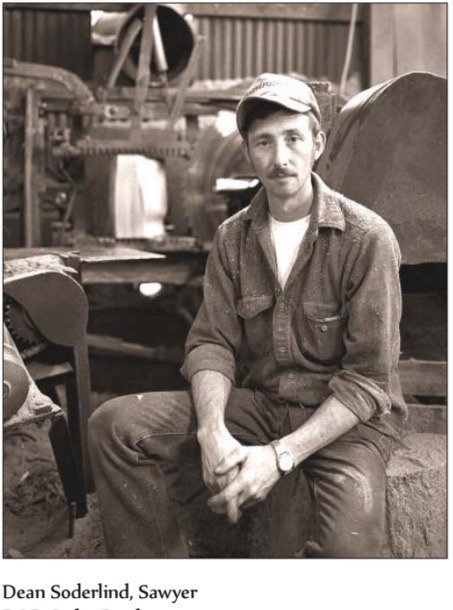On Friday, Nov. 13, the ONRC, 1455 S. Forks Ave., will host the work of John Tylczak. Tylczak came to the West End in the 1980s and photographed area logging and mill activities and the people that worked the jobs. The photos are black and white.
The evening will start with a slide presentation by Jack Zaccardo at 6 p.m. and Tylczak will speak about his work at 7 p.m.
The Forks Forum interviewed him last week …
FF: What inspired you to do these photos in this style?
John: I was inspired by the efforts of the pioneering photographers who left the comforts of their portrait studios to venture into the woods and camps with 100 pounds of gear and took exquisite images of people like my grandfather, a faller in Mason County.
FF: Can you describe the equipment used and any special processing.
John: I’ve used the same Toyo 4×5 field camera for 30 years. 4×5 means that the film is 4 by 5 inches in size. The larger sheets of film produce images with much better grain quality. Digital folks would understand this as “resolution.” The photographs are printed on heavy museum-grade paper and then toned with selenium. The selenium increased the archival quality of the print and also warms the tonal range just a bit.
FF: How did you choose to come to Forks to take the photos?
John: Twenty-five years ago loggers and shake mill workers were relatively easy to find in Forks.
FF: Did you just drive around and ask people if they could be photographed?
John: That is almost exactly how it worked. My academic training is in American social history and somewhere through my master’s program I became aware of the contribution photographers had made to our understanding of our history. My advisor at the University of Connecticut had cautioned me that if I was serious about being a historian, I would have to contribute something. My writing was fine, but photography seemed to be a more interesting avenue to meeting his challenge.
The project started with two summers in the logging sites and mills of the Simpson Timber Company in Mason County. I grew up in Shelton and Simpson had announced that they were going to close the last residential logging camp (Govey) in the state. There were people I knew who helped me get access to the company’s operations. After the second summer, I had a feeling that I might really be onto something important that was rapidly undergoing significant changes.
I was teaching at the University of Nevada at the time and was fortunate enough to receive a sabbatical grant that gave me a year (and a modest income) to further pursue the project. That was 1996-1997. That was when most of the images in the project were made.
I had prearranged with some of the sawmill owners to pay them a visit, but for the logging crews and shake mill operators, it was generally no more than finding the person who seemed to be in charge, explain what I was doing and offer to sign a liability waiver. Frequently I would hang around for half a day watching the operation … watching the light. There were only a couple of occasions where I was refused access to sites.
FF: Have the photos appeared elsewhere? you said the MOHAI? magazines? elsewhere …
John: Yes, the work has appeared in the old “Washington” magazine and in the State Museum’s “Columbia” publication.
FF: Do you have a favorite?
John: I have a lot of favorites. Last winter I digitally scanned all of the images and rediscovered a lot of wonderful photographs that I had forgotten. The pictures also have a different presence after I’ve been in the darkroom and made enlargements. Currently, I also have an exhibition of 10 images at the University of Washington in Seattle. Those photographs are 16 by 20 inches in size.
Continued next week …



